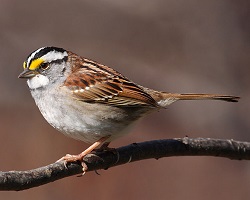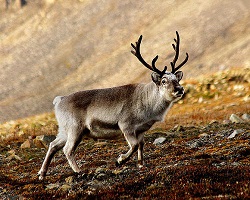Why Do Some Animals In The Taiga Experience A Seasonal Color Change?

Huge numbers of garter snakes emerge from their overwintering dens in spring. Click for more detail.
Animals of the Boreal Forest
If you walk through the Canadian taiga in early April, you may come across a bizarre phenomenon on the forest floor. At first, y'all may retrieve that someone just left a pile of shiny, twisted dark ropes on the footing. Upon closer wait, yous realize that non only is this pile wriggling, but it composed of many slender heads and tails.
Congratulations! You have stumbled upon a knot of red-sided garter snakes. This miracle occurs when warming temperatures wake garter snakes from hibernation. Males starting time emerge from their dens and wait. Once a female slithers out, the males jump on her all while wrestling each other to try to mate with the female.
If you come dorsum to the same spot in the centre of the winter, you will but find a blanket of snow on the ground. In fact, it may be difficult to find whatsoever wildlife in the taiga at all in the winter. A snowshoe hare may dart past you equally information technology sprints from a pack of hungry wolves. At night, the hoot of a Great-greyness owl may echo through the dark wood. In general, notwithstanding, the wintertime of the taiga is quiet and lone.
Sleeping Beauties

When overwintering, wood frogs not only drib their trunk temperatures, they also partially freeze. Click for more particular.
Virtually yr-round residents of the taiga are inactive through the harshest wintertime months. A few of them slumber through virtually of information technology. One time the temperatures offset dropping, these animals starting time eat as much as they tin can to store thick layers of body fat. And so, they await for dark, tranquility places. Terrestrial (land) animals such as chipmunks and garter snakes volition find burrows underground, and semi-aquatic animals like snapping turtles volition burrow into the dingy bottom of ponds.
In certain mammals, their body temperatures will drop to aid them save energy over the winter. Bears in the taiga also majority upward and sleep through the winter, but the body temperature of bears does non drop enough for their slumber to exist considered true hibernation. When these yr-circular taiga residents are sleeping, they do not consume. Luckily, they take a lot of body fatty to proceed them from going hungry. The inflow of bound and warming temperatures stir these hibernating animals from their slumbers. Information technology takes a lot of free energy to wake up, though, and these animals burn through the last of their stored trunk fatty to wake up and greet the sun.
Noisy Summer Visitors

This white-throated sparrow migrates to the taiga for the summer insect blooms in bogs. Image by Cephas.
Some animals, especially certain birds, tin can't handle the year-round taiga experience. On i paw, these birds love the warm and moist taiga summer, specially with the blooming insect populations. On the other hand, they can't deal with the winter. To solve this problem, birds such as the Siberian Thrush and White-Throated Sparrow spend their winters in the south. They drift due north so that they go far in the taiga bogs just in fourth dimension for the warm weather and the swelling clouds of mosquitoes, dragonflies, and moths.
The swampy grounds erupt with the mating calls of these migratory birds when they pause from eating to seek partners. Earlier long, eggs brainstorm hatching and baby birds start to need for food. Bird parents stuff regurgitated insects and seeds into the mouths of their offspring then that their immature can quickly grow before the curt taiga summer ends. If something happens to the nest and baby birds, at that place is not time to start again. Once temperatures begin to absurd downwards, these migratory birds pack up and motion back south.
Winter Champions
Not all animals get out before the taiga winter. Some animals, similar the Siberian tiger, the snowshoe hare, and the snow goose not only live in the taiga for the entire year, but likewise remain awake through the wintertime.

Though many animals avert the freezing taiga wintertime, that is the only season arid-ground caribou tin can live in the taiga. It is as well warm in the summer months, so they migrate to the colder tundra for the summer. Prototype by Per Harald Olsen.
To survive, these animals have special adaptations like big paws to maneuver through the snow and thick coats to protect against the biting common cold. Snowshoe hares lose their summer brown coat and abound one in winter white to help them alloy into the wintertime landscape.
Fish that alive in the lakes and ponds of the taiga have little choice over whether or not to spend the winter in the boreal forest. When temperatures driblet below freezing, the surface of the lake freezes over. Luckily, because ice is lighter than water, ice remains on the surface. Fish similar northern freeway and Alaska blackfish alive nether the ice at near-freezing temperatures.
Images via Wikimedia Eatables. Wolves by Vargar.
Janet Storey's forest frog image: Ask A Biologist tries to ensure proper permissions before posting items on this website. For this image we take not been able to reach the copyright owner. If you have information regarding the copyright possessor, delight contact Ask A Biologist using the feedback link in the gold box to the right.
Source: https://askabiologist.asu.edu/animals-taiga
Posted by: manningmervagands1939.blogspot.com

0 Response to "Why Do Some Animals In The Taiga Experience A Seasonal Color Change?"
Post a Comment